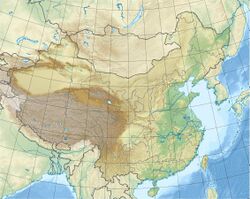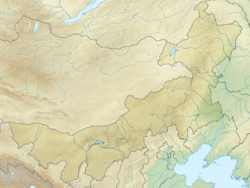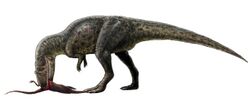Earth:Ulansuhai Formation
From HandWiki
| Ulansuhai Formation Stratigraphic range: Turonian ~92 Ma | |
|---|---|
| Type | Geological formation |
| Unit of | Dashuigou Group |
| Lithology | |
| Primary | Claystone, siltstone |
| Location | |
| Coordinates | [ ⚑ ] : 40°18′N 105°54′E / 40.3°N 105.9°E |
| Paleocoordinates | [ ⚑ ] 41°30′N 97°12′E / 41.5°N 97.2°E |
| Region | Inner Mongolia |
| Country | |
The Ulansuhai Formation (simplified Chinese: 乌兰苏海组; traditional Chinese: 烏蘭蘇海組; pinyin: Wūlánsūhǎi Zǔ) is a geological formation in Inner Mongolia, north China. Dinosaur remains are among the fossils that have been recovered from the formation.[1]
The Ulansuhai Formation has traditionally been considered to date to the Aptian-Albian stages of the Lower Cretaceous, due to similarities between the Ulansuhai fauna and known Aptian formations.[1] However, radiometric dating done on underlying formations has shown this to be incorrect. Due to the age of underlying rocks, the Ulansuhai Formation cannot be older than the Turonian stage of the Late Cretaceous, about 92 Ma.[2][3]
Fossil content
Dinosaurs
| Dinosaurs | ||||
|---|---|---|---|---|
| Taxa | Presence | Description | Images | |
| Chilantaisaurus tashuikouensis[1] | A Neovenatorid.[4] "Fragmentary postcranial skeleton."[5] | |||
| Gobisaurus domoculus[1] | An ankylosaur. "Skull [and possible] postcranium."[6] | |||
| Shaochilong maortuensis[1] | A carcharodontosaurid, formerly Chilantaisaurus maortuensis. | |||
| Sinocephale bexelli[7] | A Pachycephalosaurid, known from now lost skull fragments. Formerly Troodon bexelli. | |||
| Sinornithomimus dongi[8][1] | An ornithomimid. "[Fourteen] skeletons, juvenile to adult."[9] | |||
| Indeterminate Iguanodontian[1] | ||||
Testudines
| Taxa | Presence | Description | Images |
|---|---|---|---|
| Kuhnemys maortuensis[10] | A Pantrionychid turtle |
Ostracods
| Taxa | Presence | Description | Image |
|---|---|---|---|
| cf. Cypridea[8] | A Cyprideid |
See also
- List of dinosaur-bearing rock formations
References
- ↑ 1.0 1.1 1.2 1.3 1.4 1.5 1.6 Weishampel, David B; et al. (2004). "Dinosaur distribution (Early Cretaceous, Asia)." In: Weishampel, David B.; Dodson, Peter; and Osmólska, Halszka (eds.): The Dinosauria, 2nd, Berkeley: University of California Press. Pp. 563-570. ISBN:0-520-24209-2.
- ↑ Kobayashi, Y., and Lu, J.-C. (2003). "A new ornithomimid dinosaurian with gregarious habits from the Late Cretaceous of China." Acta Palaeontol. Pol., 48: 235–259.
- ↑ Benson, R.B.J. and Xu, X. (2008). "The anatomy and systematic position of the theropod dinosaur Chilantaisaurus tashuikouensis Hu, 1964 from the Early Cretaceous of Alanshan, People’s Republic of China." Geol. Mag., 145: 778–789. doi:10.1017/S0016756808005475
- ↑ Benson, R.B.J., Carrano, M.T and Brusatte, S.L. (2010). "A new clade of archaic large-bodied predatory dinosaurs (Theropoda: Allosauroidea) that survived to the latest Mesozoic." Naturwissenschaften, 97(1):71–78. doi:10.1007/s00114-009-0614-x
- ↑ "Table 4.1," in Weishampel, et al. (2004). Page 73.
- ↑ "Table 17.1," in Weishampel, et al. (2004). Page 364.
- ↑ Evans, David; Brown, Caleb M.; You, Hailu; Campione, Nicolás E. (2021). "Description and revised diagnosis of Asia's first recorded pachycephalosaurid, Sinocephale bexelli gen. nov., from the Upper Cretaceous of Inner Mongolia, China". Canadian Journal of Earth Sciences e-First (10): 981–992. doi:10.1139/cjes-2020-0190. https://cdnsciencepub.com/doi/full/10.1139/cjes-2020-0190.
- ↑ 8.0 8.1 Kobayashi and Lu, Yoshitsugu and Jun-Chang (2003). "A new ornithomimid dinosaur with gregarious habits from the Late Cretaceous of China". Acta Palaeontologica Polonica 48 (2): 235–259. https://www.researchgate.net/publication/254961054.
- ↑ "Table 5.1," in Weishampel, et al. (2004). Page 138.
- ↑ S.-Y. Hu. 1964. [Carnosaurian remains from Alashan, Inner Mongolia]. Vertebrata PalAsiatica. 8(1):42-63
 |







